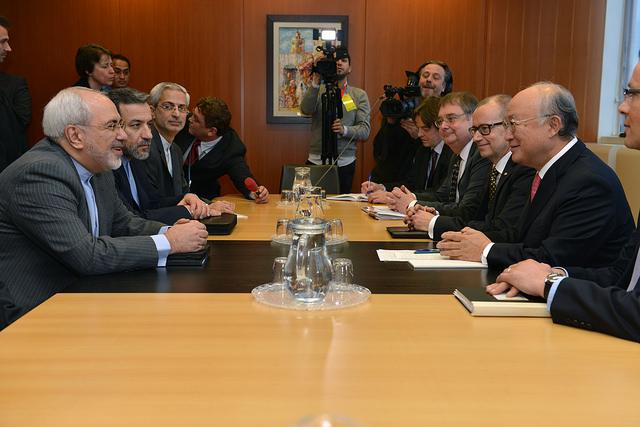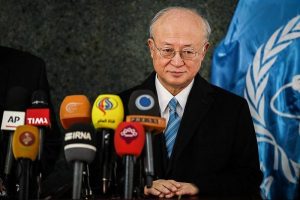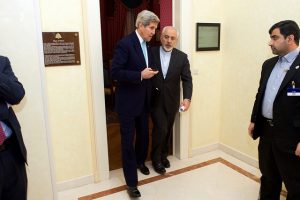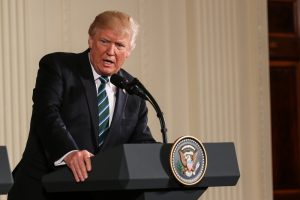by Peter Jenkins
Iran and the International Atomic Energy Agency (IAEA) issued a joint statement on May 21 to the effect that they had agreed on a further set of practical measures within the framework of their November 11, 2013 cooperation agreement. The first two measures relate to IAEA concerns about a possible military dimension (PMD) to Iran’s nuclear program, and the other three to Iran’s Nuclear Non-Proliferation Treaty (NPT) safeguards agreement:
1) Exchanging information with the Agency with respect to the allegations related to the initiation of high explosives, including the conduct of large-scale high explosives experimentation in Iran.
2) Providing mutually agreed relevant information and explanations related to studies made and/or papers published in Iran in relation to neutron transport and associated modelling and calculations and their alleged application to compressed materials.
3) Providing mutually agreed information and arranging a technical visit to a centrifuge research and development centre.
4) Providing mutually agreed information and managed access to centrifuge assembly workshops, centrifuge rotor production workshops, and storage facilities, as well as concluding the safeguards approach for the IR-40 reactor.
The aim is to complete implementation of these measures by Aug. 25, 2014. This is the third of such sets. The first was announced on November 11 of last year, the second on February 20.
The absence in Wednesday’s statement of any news about implementation of the Feb. 20 measures is almost certainly insignificant. The IAEA reported on implementation of the Nov. 11 measures in one of its quarterly reports on Iran to the IAEA Board of Governors. It can be inferred that the IAEA intends to report on those Feb. 20 measures in the quarterly report that will likely be issued some ten days before a June 2 meeting of the Board.
A particularly interesting feature of that report will be the IAEA’s findings in relation to the last of the Feb. 20 measures: “Providing information and explanations for the Agency to assess Iran’s stated need…for the development of Exploding Bridge Wire [EBW] detonators”. Since February 22, 2008, if not earlier, the IAEA has believed that such detonators could “be relevant to nuclear weapon R&D”. Will Iran have succeeded in persuading the IAEA that its development of EBW detonators was for conventional military or even civil applications? “EBW detonators are the standard in virtually all conventional military applications and in the mining industry. There is a huge market for them. So characterising them as an indicator of a nuclear weapons program is odd” Robert Kelley, a nuclear weapons expert who has worked at the IAEA, told LobeLog.
Items 1 and 2 in the new list are IAEA concerns first made public in the annex to GOV/2011/65 of November 8, 2011.
In paragraph 57 of that annex, at the end of a section on the neutron initiation of nuclear explosions, the IAEA stated: “Given the importance of neutron generation and transport, and their effect on geometries containing fissile materials in the context of an implosion device, Iran needs to explain to the Agency its objectives and capabilities in this field”.
Paragraphs 47-51 of the same annex relate to alleged Iranian “hydrodynamic experiments”. They detail information made available to the IAEA by third parties; this information suggested that Iran had manufactured surrogate nuclear weapon components (not using fissile or nuclear material) and might have used those surrogates in high explosive experiments.
The fact that Iran is now ready to address these concerns is promising. It suggests a decision in Tehran to be more cooperative than in the past in resolving issues that have enabled Iran’s enemies to impute to Iran the blackest of nuclear intentions.
Nonetheless, it is to be seen whether the IAEA will be satisfied if Iran declines to provide answers that indicate a nuclear weapon connection — if, for instance, they point to a nuclear reactor connection. “Neutron transport is important in reactors as well as nuclear weapons,” remarks Kelley. Can the IAEA bring itself to accept answers that do not support the nuclear weapon accusations that have been leveled at Iran?
The last point to note about this week’s statement is the target completion date of Aug. 25. This is a reminder that the IAEA is pursuing its investigations into Iranian compliance with its NPT safeguards obligations, and alleged nuclear-related activities, in parallel with, but without any formal connection to the negotiations on which the US, Iran and five other powers have embarked pursuant to the November 24, 2013 Joint Plan of Action (JPOA).
It also suggests that the parties to this negotiation have agreed that the resolution of all PMD concerns is not a necessary precondition for agreeing the “comprehensive solution” envisaged in the JPOA, since the negotiation parties continue to hope that, despite recent difficulties, they can wrap up their work by July 20 or thereabouts.
Photo: IAEA Director General Yukiya Amano meett with Iranian Foreign Minister Mohammad Javed Zarif at IAEA headquarters in Vienna on February 18 on the margins of the nuclear-related talks between Iran and world powers. Credit: Dean Calma/IAEA






Sure Norman. The 30,000 centrifuge request came from the Iranian foreign ministry and was reported on official state news services such as Fars. The enrichment data comes from the International Atomic Energy Agency, as well as official Iranian government reporting. Both data sets have run broadly in Western media such as the New York Times, Guardian, Associated Press and others. The data about Iran receiving billions in released funds was widely reported by both Western news agencies and the Iranian government. The reference to Iran’s ruling mullahs comes reading the Iranian constitution which sets out the power structure as it relates to the clergy’s primacy in all state matters, including oversight and veto power on all decisions relating to foreign policy, including international treaties. The document also clearly outlines the clergy’s role in overseeing civil and criminal justice and the military. Hence the reference to human rights improvements since arrest, imprisonment and execution without trial by peers seems to be the preferred operating method. Information regarding Iranian executions can be found with Amnesty International, Human Rights Watch and the UN High Commissioner’s Office on civil rights. I hope that provides a comprehensive enough answer for you. If you like I can provide the URLs for these sources so you can educate yourself better?
To Mike F, Do provide the dates of these publications you’ve mentioned. I haven’t read anywhere that Iran has received $Billions in relief from the sanctions, from any of those you mention. As for the Mullahs, human rights, etc., you could also state a case for just about every country on that basis, Oh, and citing those publications again, one should use a skeptical eye to what is printed in them, considering they print only what the government[s] want them to, while with holding the whole story, censorship if you will.
As an aside, I did find it refreshing to read about the hanging in Iran of a fraudulent banker who scammed $Billions there. Too bad the U.S.Government has failed to put those who scam the taxpayers in the U.S. for all those $Billions/Trillions.
Here is a link to an article from Iran state TV detailing fourth and fifth payments released to Iran as part of the nuclear negotiation on April 18th. $2.55 billion of the promised $4.2 billion under the agreement have so far been returned back to Iran.
The news also appears in many other Western publications. If you Google “Marie Harf Iran nuclear frozen funds” you will see many, many stories on this topic, both in the Muslim world and Western news media.
As to your comment about being happy about someone getting hanged, I think it worth mentioning that I oppose the death penalty in Iran, the U.S. and any other nation. I find any society that employs it to be barbaric and people who call for its liberal use to be less than civilized. The mark of any society’s greatness comes not in what it achieves, but comes from how it is able to correct and nurture the worst aspects of itself.
To Mike F. Those $Billions you spoke of in your first comment, tuirns out to be $2 Billions, not very much when you consider all the hassle that has gone on under the bridge. As for coupling the human rights with the present negotiations, you’re naive if you think that would have gotten Iran to the table on the Nuclear issue[s]. As for propaganda, believability depends on which side of the fence one sits.
The $2.5 billion was divided into five tranches. The agreement as a whole covers $4.2 billion. This is considered a “test” by the negotiators in order to determine Iran’s ability to meet initial deadlines since past history leaves much to be desired. Of course it’s a small amount of the over $200 billion still being held in frozen assets. Hence the term “test.”
As for the linkage of human rights, I never said human rights got Iran to the negotiating table. Cash or the lack thereof is what got Iran to the table and the shutting of off access to international currency transfer exchanges which was a critical blow to Iran’s ability to operate as a modern economy.
What I did say is that similar to what the West has demanded of other regimes such as the old Soviet Union and North Korea, there should be a linkage between human rights improvements and rewards. It’s the same approach you take in training an animal which is appropriate in this case when you consider the brutal nature of the Iranian mullahs.
I don’t quite understand why these concepts are so hard for you to understand, unless of course you’re only aim is to disregard human rights and simply blank check anything the mullahs want, in which case there is not much point in continuing this discussion since we would operating from completely foreign frames of reference.